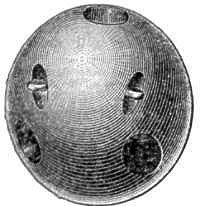Carcass (projectile)

Acarcasswas an early form ofincendiarybomborshell,intended to set targets on fire. It comprised an external casing, usually ofcast iron,filled with a highly flammable mixture, and having three to five holes through which the burning filling could blaze outward.[1][2]Carcasses were shot fromhowitzers,mortars,and othercannonsto set fire to buildings anddefences;on impact, the shell shattered, spreading its incendiary filling around the target.Congreve rocketswere also sometimes fitted with carcass heads.
They were namedcarcassbecause the circles which pass from one ring, or plate, to the other, were thought to resemble the ribs of a humancarcass.[2]
History
[edit]Carcasses were used for the first time by the French and Münsterite troops underLouis XIVandBernard von Galenin 1672.[3]They were also fired frombomb vessels.
The carcass shell as used by theRoyal Navyin the 18th and early 19th century, most famously in the attack onFort McHenry,was a hollow cast iron sphere weighing 190 pounds (86 kg). Instead of the singlefusehole found on a conventionalmortarshell of the period, the carcass had 3 openings, each 3 inches (76 mm) in diameter. Its filling burned for 11 minutes upon firing. It was especially useful during night bombardments, as the burning projectile assisted in the aiming of the cannon.[4]
Composition
[edit]For the composition of the flammable material used in a carcass, 18th century philosopherChristian Wolffprescribed 10 parts of poundedgunpowder,2 ofnitre,1 ofsulfur,and 1 ofcolophony;or 6 of gunpowder, 4 of nitre, 4 of sulfur, 1 of beaten glass, 0.5 ofantimony0.5 ofcamphor,1 ofsal ammoniac,and 0.25 of commonsalt.For the shell, he started with two iron rings (others used plates), fitting one at one extreme, near the aperture at which the carcass was to be fired, and the other at the other. These he braced with cords drawn lengthwise; and across these, at right angles, laced other cords, making a knot at each intersection. Between the folds of the cords, he made holes, inserted copper tubes, and filled them half full of powder and lead bullets, packing it in with a tow. The internal shell's aperture was then plugged up, and it was immersed in a mixture of 4 parts of meltedpitch,20 ofrosin,1 ofoil of turpentine,and as much ground gunpowder as was needed to reduce it to the consistency of a paste. After immersion, the shell was to be covered withtow,and immersed again, until it was the proper size for the mortar.[2]
Carcass shells as used by the Royal Navy from the 18th to the 19th centuries were filled with a mixture ofsaltpeter,sulfur, rosin,sulfide of antimony,tallowandturpentine.
See also
[edit]References
[edit]- ^"Carcass".Oxford English Dictionary.Oxford University Press. 2nd edition. 1989.
- ^abc
 This article incorporates text from a publication now in thepublic domain:Chambers, Ephraim,ed. (1728). "Carcass".Cyclopædia, or an Universal Dictionary of Arts and Sciences(1st ed.). James and John Knapton, et al.
This article incorporates text from a publication now in thepublic domain:Chambers, Ephraim,ed. (1728). "Carcass".Cyclopædia, or an Universal Dictionary of Arts and Sciences(1st ed.). James and John Knapton, et al.
- ^Nicolas Édouard Delabarre-DuparcqandGeorge Washington Cullum.Elements of Military Art and History.1863. p 142.
- ^"HMS Volcano: and the Carcasses Red Glare, September 13, 1814".ScienceViews.Retrieved2008-07-07.
